COVID lung patients see surprising improvement, though some continue to struggle
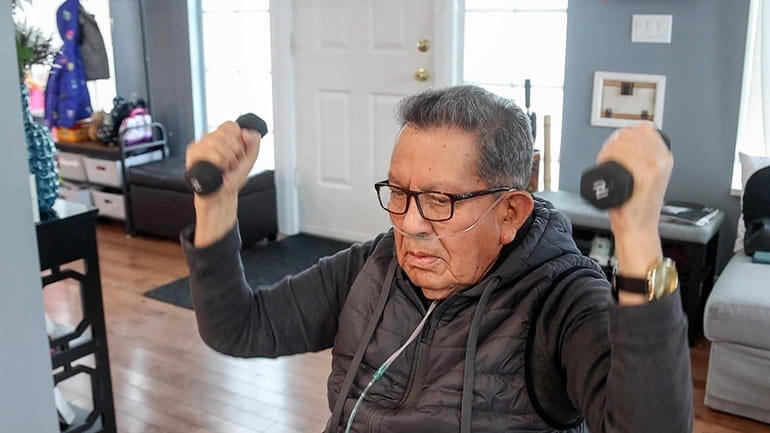
Hospitalized with COVID-19 for three weeks in 2021, Guillermo Guzhnay Pauta, of Lynbrook, has recovered more than his doctors and family expected. Credit: Newsday/John Paraskevas
Hospitalized with COVID-19 in 2021, Guillermo Guzhnay Pauta was so weak and had so much trouble breathing that he did not think he would survive. A doctor talked to the family about home hospice care.
“I have a lot of faith in God, and I explained to him that he can take me, that I don’t want to suffer,” Guzhnay Pauta, 82, of Lynbrook, said in Spanish.
Even after arriving home, Guzhnay Pauta spent months bedridden. But today, he sometimes can disconnect from his oxygen machine, and he feels well enough that he’s hoping to travel to his native Ecuador this summer — far more progress than his family and doctors ever believed possible.
“He’s really a miracle,” his daughter, Cristina Rivera, said.
He’s not the only one. Pulmonologists have marveled as patients who once were on the brink of death from COVID-19 recovered much more than expected. And they’re seeing far fewer new COVID-19 patients with major lung problems, a reflection of a disease that causes significantly less severe illness than when the World Health Organization declared COVID-19 a pandemic on March 11, 2020.
“Fortunately very few cases get referred to me anymore, because COVID is a much more manageable, mild disease” for most people, said Dr. Gita Lisker, director of the respiratory care unit at Long Island Jewish Medical Center in New Hyde Park.
COVID-19 is a respiratory illness, and although it can damage organs throughout the body, it can be especially devastating to the lungs and to the respiratory system as a whole. A study released in late 2022 found that 11% of COVID-19 patients who left the hospital before March 2021 had residual lung damage after discharge — although researchers cautioned that the results do not reflect the milder infections that were more common after the data was gathered.
Early in the pandemic, overwhelmed hospitals scrambled to obtain enough ventilators to treat patients who arrived in ambulances gasping for air. Elective surgeries were temporarily banned statewide to make way for the influx of patients, many with breathing problems, who sometimes had to sleep in beds in hallways while waiting for a room.
Today, though, the virus no longer usually invades lower respiratory tracts, so lung damage and conditions like pneumonia are less common, said Lisker, who runs a post-COVID-19 outpatient program for those with lung issues.
Researchers who have documented the “drastic reduction” in pneumonia and other lower respiratory problems related to the virus say that it is part of the evolution of COVID-19 variants, and that it could be because newer variants are less virulent, more people received vaccines or received immunity from previous infections, care improved for COVID-19 patients – or some combination of those factors.
Most new patients in the post-COVID program had severely weakened immune systems before they were infected, Lisker said.
Yet even as many fewer people face breathing problems from new COVID-19 infections, some whose lungs were ravaged earlier by the coronavirus continue to struggle. Guzhnay Pauta still needs oxygen most nights, and when he goes up the stairs and otherwise exerts himself.
Some people likely will never fully recover.
“I’m never going to be who I was,” said Martha Raffloer, of Wantagh, a mother of two young children who spent 122 days in the hospital in 2021. “My normal is gone. That person doesn't exist anymore.”
Lisker recalled how in the spring of 2020 there were lines of patients on ventilators and doctors desperately trying to find out which treatments worked.
“I think we all to some extent have a sort of PTSD from that time in our lives,” she said.
Roy Owens, 72, of Laurelton, Queens, said when he was hospitalized at Long Island Jewish for six weeks in April and May of 2020 with severe breathing problems, roommate after roommate died.
“Every other day, I see them wheel out dead people,” he said. “They wheel out one dead person today, and they come in with someone else the next day, and two days after that, another dead person is wheeled out. I saw about 10 people wheeled out. Every time, I thought, is it me next?”
He also watched television news shows that broadcast reports of the hundreds of New Yorkers who were dying of the disease every day.
“It was terrible,” he said.
Nearly 1.2 million people nationwide, and about 10,800 Long Islanders, have died of COVID-19-related causes, according to the Centers for Disease Control and Prevention. But fatalities have dropped precipitously, with more than 11 times fewer deaths in 2023 on Long Island compared with 2020, according to CDC data that is still provisional for 2023.
Dr. Frank Coletta, a pulmonologist and chief of critical care medicine at Mount Sinai South Nassau hospital in Oceanside, said physicians were “caught off-guard” in the early days of the pandemic by a new virus that affected the body in sometimes confounding ways.
“It was very frustrating to not be able to at first understand the physiology so you can come up with a game plan, but also to see the rapidity with which some patients declined,” he said.
Ventilators can save lives of people with severe breathing problems. But physicians have discovered that COVID-19 weakens the lungs more than most respiratory illnesses, and ventilators pushing air into them can cause further damage, Coletta said. Today, ventilators are used more sparingly, and strategies such as "proning" — turning patients on their stomachs, which can help with breathing — can help forestall the use of ventilators, he said.
Far fewer patients are considered for ventilators today, he said. The body is better able to fight the virus, largely because of immunity built up by vaccines and previous infection, and because the virus is less virulent, Coletta said
Still, many who contracted COVID-19 earlier in the pandemic now have long COVID, defined by the CDC as effects of the virus at least four weeks after infection. Symptoms of long COVID can vary greatly depending on the person, and for many people with common symptoms such as fatigue, tests may not detect any problems, and the cause is a mystery.
Even lung tests for people with regularly occurring breathlessness sometimes come back normal, said Dr. Abigail Chua, a pulmonologist at the Stony Brook Medicine Post-COVID Clinic in Lake Grove.
It’s not completely clear why, but studies have shown that the virus can cause dysfunction in the diaphragm, which is the primary muscle that helps us breathe, she said.
Chua said she recently received Stony Brook University funding for a long COVID study on whether breathing exercises used by opera singers can lead to “an improvement in the muscle tone of the diaphragm, and whether people’s day-to-day lives are any better.”
She hopes to recruit 150 people for the study, partner with the Stony Brook music department and begin research in the summer.
A relatively small number of people whose lungs were damaged by COVID-19 have fibrosis, a condition that causes scarring and breathing problems and is typically irreversible. But some patients who initially were thought to have fibrosis started to get better, Chua said.
“This [damaged lung] that normally isn’t reversible reverses, and the question is why,” she said.
The abnormalities seen in these COVID-19 patients are sometimes similar in appearance to classic fibrosis, she said, but in these cases, “the lung surprised us and the patient surprised us.”
The scarring on the lower parts of Raffloer’s lungs is a different type of scarring from that in classic end-stage fibrosis, Lisker said. In her case, the other parts of her lung have taken over more of her breathing and improved lung capacity, Lisker said.
Her recovery has been slow — but consistent, and more than she ever expected. For a year after she returned to the hospital, she had to live in a guest room on the first floor of her home, because she was unable to go up the stairs to her bedroom.
Raffloer now can be off oxygen if she is not doing anything strenuous, although she still needs it at night, when the body, whether with lung problems or not, has lower levels of oxygen.
“Because I was so sick, I never thought in a million years I could sit without any oxygen on,” she said.
But she still cannot exert herself too much. Vacuuming “feels like a workout,” similar to the hourlong kickboxing classes that she used to take pre-pandemic, and that she could never handle today.
Guzhnay Pauta also still sometimes struggles to breathe, and his hope of visiting his native Cuenca, Ecuador, is complicated by the Andean city’s altitude of more than a mile and a half above sea level, because oxygen levels drop as altitude rises.
Guzhnay Pauta said he hopes he’ll continue to improve enough to travel, and will consult with Lisker, who is wary of him visiting a high-altitude city.
He is dramatically better than when he was in the hospital and rehabilitation center, his daughter, Cristina Rivera, said.
“He was like a baby,” needing help to eat, go to the bathroom and anything else, Rivera said.
Now he goes on walks, has an exercise bike and does arm exercises with small weights, she said.
Owens has to stop and catch his breath after walking three or four blocks, or after going up the stairs of his home. But he’s grateful for his progress.
While in the hospital, “Every night I would go to sleep and think I’m not going to make it,” he said. “I was raised from the dead.”
Raffloer also thinks of how she could have died, leaving her now 4-year-old son and 7-year-old daughter without a mother. Her outlook is positive, even as she is resigned to never being able to breathe normally again.
“I'm just happy to be here,” she said. “Like, if the worst of it is that I have to use oxygen for the rest of my life, I'm OK with that. I'm here with my kids. I can see them, I can hold them, I can take care of them as best as I can with the oxygen.”
Hospitalized with COVID-19 in 2021, Guillermo Guzhnay Pauta was so weak and had so much trouble breathing that he did not think he would survive. A doctor talked to the family about home hospice care.
“I have a lot of faith in God, and I explained to him that he can take me, that I don’t want to suffer,” Guzhnay Pauta, 82, of Lynbrook, said in Spanish.
Even after arriving home, Guzhnay Pauta spent months bedridden. But today, he sometimes can disconnect from his oxygen machine, and he feels well enough that he’s hoping to travel to his native Ecuador this summer — far more progress than his family and doctors ever believed possible.
“He’s really a miracle,” his daughter, Cristina Rivera, said.
WHAT TO KNOW
COVID-19 is a respiratory disease that can still damage the lungs. But serious lung damage is much less common than when the pandemic began four years ago.
Doctors say they are surprised by how much progress some people have made in recovering from COVID-19-related lung damage they initially thought was irreversible.
- A Stony Brook Medicine study aims to find out whether the same types of breathing exercises that opera singers use can strengthen the diaphragms of long COVID patients who continue to experience breathlessness.
He’s not the only one. Pulmonologists have marveled as patients who once were on the brink of death from COVID-19 recovered much more than expected. And they’re seeing far fewer new COVID-19 patients with major lung problems, a reflection of a disease that causes significantly less severe illness than when the World Health Organization declared COVID-19 a pandemic on March 11, 2020.
“Fortunately very few cases get referred to me anymore, because COVID is a much more manageable, mild disease” for most people, said Dr. Gita Lisker, director of the respiratory care unit at Long Island Jewish Medical Center in New Hyde Park.
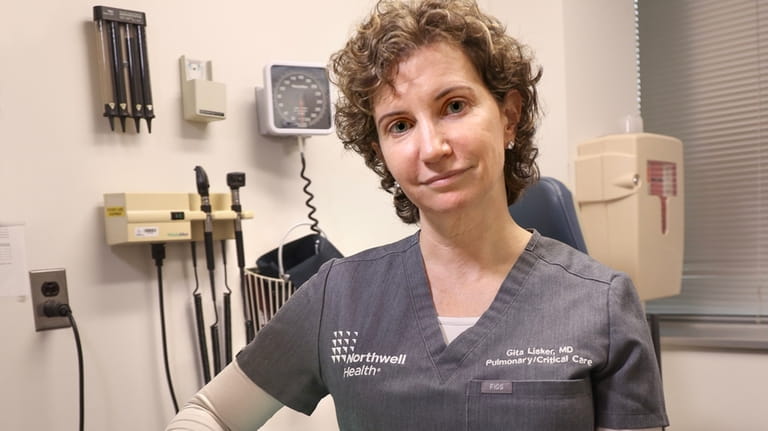
"COVID is a much more manageable, mild disease" for most people, said Dr. Gita Lisker, director of the respiratory care unit at Long Island Jewish Medical Center. Credit: Newsday/John Paraskevas
COVID-19 is a respiratory illness, and although it can damage organs throughout the body, it can be especially devastating to the lungs and to the respiratory system as a whole. A study released in late 2022 found that 11% of COVID-19 patients who left the hospital before March 2021 had residual lung damage after discharge — although researchers cautioned that the results do not reflect the milder infections that were more common after the data was gathered.
Early in the pandemic, overwhelmed hospitals scrambled to obtain enough ventilators to treat patients who arrived in ambulances gasping for air. Elective surgeries were temporarily banned statewide to make way for the influx of patients, many with breathing problems, who sometimes had to sleep in beds in hallways while waiting for a room.
Today, though, the virus no longer usually invades lower respiratory tracts, so lung damage and conditions like pneumonia are less common, said Lisker, who runs a post-COVID-19 outpatient program for those with lung issues.
Researchers who have documented the “drastic reduction” in pneumonia and other lower respiratory problems related to the virus say that it is part of the evolution of COVID-19 variants, and that it could be because newer variants are less virulent, more people received vaccines or received immunity from previous infections, care improved for COVID-19 patients – or some combination of those factors.
Most new patients in the post-COVID program had severely weakened immune systems before they were infected, Lisker said.
Yet even as many fewer people face breathing problems from new COVID-19 infections, some whose lungs were ravaged earlier by the coronavirus continue to struggle. Guzhnay Pauta still needs oxygen most nights, and when he goes up the stairs and otherwise exerts himself.
Some people likely will never fully recover.
“I’m never going to be who I was,” said Martha Raffloer, of Wantagh, a mother of two young children who spent 122 days in the hospital in 2021. “My normal is gone. That person doesn't exist anymore.”
'PTSD' from spring 2020
Lisker recalled how in the spring of 2020 there were lines of patients on ventilators and doctors desperately trying to find out which treatments worked.
“I think we all to some extent have a sort of PTSD from that time in our lives,” she said.
Roy Owens, 72, of Laurelton, Queens, said when he was hospitalized at Long Island Jewish for six weeks in April and May of 2020 with severe breathing problems, roommate after roommate died.
“Every other day, I see them wheel out dead people,” he said. “They wheel out one dead person today, and they come in with someone else the next day, and two days after that, another dead person is wheeled out. I saw about 10 people wheeled out. Every time, I thought, is it me next?”
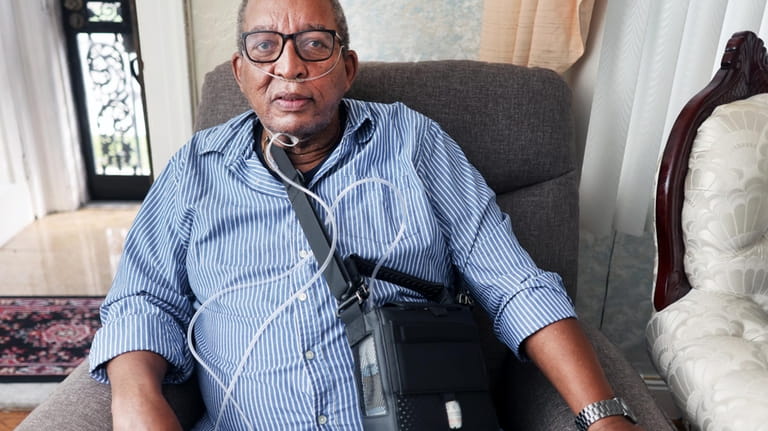
Roy Owens, 72 of Laurelton, still has to stop and catch his breath after walking three or four blocks, but he’s grateful for his progress. Credit: Debbie Egan-Chin
He also watched television news shows that broadcast reports of the hundreds of New Yorkers who were dying of the disease every day.
“It was terrible,” he said.
Nearly 1.2 million people nationwide, and about 10,800 Long Islanders, have died of COVID-19-related causes, according to the Centers for Disease Control and Prevention. But fatalities have dropped precipitously, with more than 11 times fewer deaths in 2023 on Long Island compared with 2020, according to CDC data that is still provisional for 2023.
Dr. Frank Coletta, a pulmonologist and chief of critical care medicine at Mount Sinai South Nassau hospital in Oceanside, said physicians were “caught off-guard” in the early days of the pandemic by a new virus that affected the body in sometimes confounding ways.
“It was very frustrating to not be able to at first understand the physiology so you can come up with a game plan, but also to see the rapidity with which some patients declined,” he said.
Ventilators can save lives of people with severe breathing problems. But physicians have discovered that COVID-19 weakens the lungs more than most respiratory illnesses, and ventilators pushing air into them can cause further damage, Coletta said. Today, ventilators are used more sparingly, and strategies such as "proning" — turning patients on their stomachs, which can help with breathing — can help forestall the use of ventilators, he said.
Far fewer patients are considered for ventilators today, he said. The body is better able to fight the virus, largely because of immunity built up by vaccines and previous infection, and because the virus is less virulent, Coletta said
Opera exercises for long COVID
Still, many who contracted COVID-19 earlier in the pandemic now have long COVID, defined by the CDC as effects of the virus at least four weeks after infection. Symptoms of long COVID can vary greatly depending on the person, and for many people with common symptoms such as fatigue, tests may not detect any problems, and the cause is a mystery.
Even lung tests for people with regularly occurring breathlessness sometimes come back normal, said Dr. Abigail Chua, a pulmonologist at the Stony Brook Medicine Post-COVID Clinic in Lake Grove.

Dr. Abigail Chua at Stony Brook University Hospital said studies have shown that the virus can cause dysfunction in the diaphragm. Credit: Morgan Campbell
It’s not completely clear why, but studies have shown that the virus can cause dysfunction in the diaphragm, which is the primary muscle that helps us breathe, she said.
Chua said she recently received Stony Brook University funding for a long COVID study on whether breathing exercises used by opera singers can lead to “an improvement in the muscle tone of the diaphragm, and whether people’s day-to-day lives are any better.”
She hopes to recruit 150 people for the study, partner with the Stony Brook music department and begin research in the summer.
Continuing mysteries of COVID and lungs
A relatively small number of people whose lungs were damaged by COVID-19 have fibrosis, a condition that causes scarring and breathing problems and is typically irreversible. But some patients who initially were thought to have fibrosis started to get better, Chua said.
“This [damaged lung] that normally isn’t reversible reverses, and the question is why,” she said.
The abnormalities seen in these COVID-19 patients are sometimes similar in appearance to classic fibrosis, she said, but in these cases, “the lung surprised us and the patient surprised us.”
The scarring on the lower parts of Raffloer’s lungs is a different type of scarring from that in classic end-stage fibrosis, Lisker said. In her case, the other parts of her lung have taken over more of her breathing and improved lung capacity, Lisker said.
Her recovery has been slow — but consistent, and more than she ever expected. For a year after she returned to the hospital, she had to live in a guest room on the first floor of her home, because she was unable to go up the stairs to her bedroom.
Raffloer now can be off oxygen if she is not doing anything strenuous, although she still needs it at night, when the body, whether with lung problems or not, has lower levels of oxygen.
“Because I was so sick, I never thought in a million years I could sit without any oxygen on,” she said.
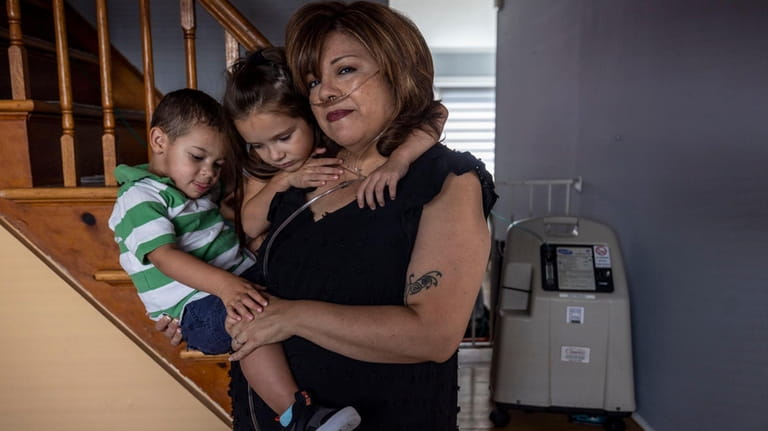
In 2022, long COVID sufferer Martha Raffloer with her kids, Daniel, 2, and Annelise, 5, at her Wantagh home. Credit: Newsday/Alejandra Villa Loarca
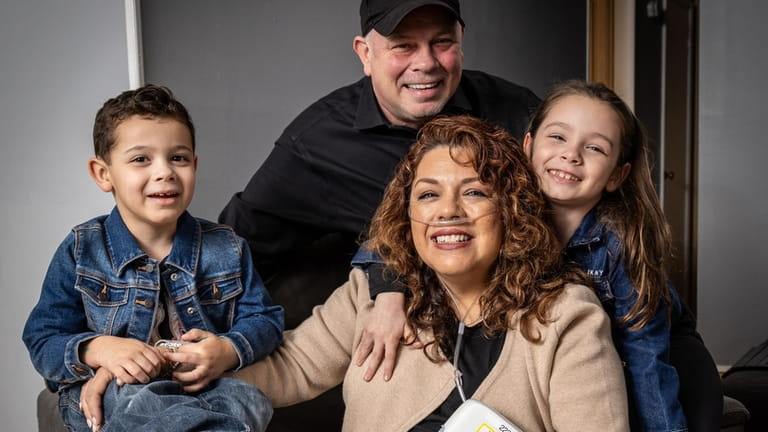
Raffloer with her kids and husband, Daniel, on Thursday. She now can be off oxygen if she's not doing anything strenuous. Credit: Newsday/J. Conrad Williams Jr.
But she still cannot exert herself too much. Vacuuming “feels like a workout,” similar to the hourlong kickboxing classes that she used to take pre-pandemic, and that she could never handle today.
Guzhnay Pauta also still sometimes struggles to breathe, and his hope of visiting his native Cuenca, Ecuador, is complicated by the Andean city’s altitude of more than a mile and a half above sea level, because oxygen levels drop as altitude rises.
Guzhnay Pauta said he hopes he’ll continue to improve enough to travel, and will consult with Lisker, who is wary of him visiting a high-altitude city.
He is dramatically better than when he was in the hospital and rehabilitation center, his daughter, Cristina Rivera, said.
“He was like a baby,” needing help to eat, go to the bathroom and anything else, Rivera said.
Now he goes on walks, has an exercise bike and does arm exercises with small weights, she said.
Owens has to stop and catch his breath after walking three or four blocks, or after going up the stairs of his home. But he’s grateful for his progress.
While in the hospital, “Every night I would go to sleep and think I’m not going to make it,” he said. “I was raised from the dead.”
Raffloer also thinks of how she could have died, leaving her now 4-year-old son and 7-year-old daughter without a mother. Her outlook is positive, even as she is resigned to never being able to breathe normally again.
“I'm just happy to be here,” she said. “Like, if the worst of it is that I have to use oxygen for the rest of my life, I'm OK with that. I'm here with my kids. I can see them, I can hold them, I can take care of them as best as I can with the oxygen.”

